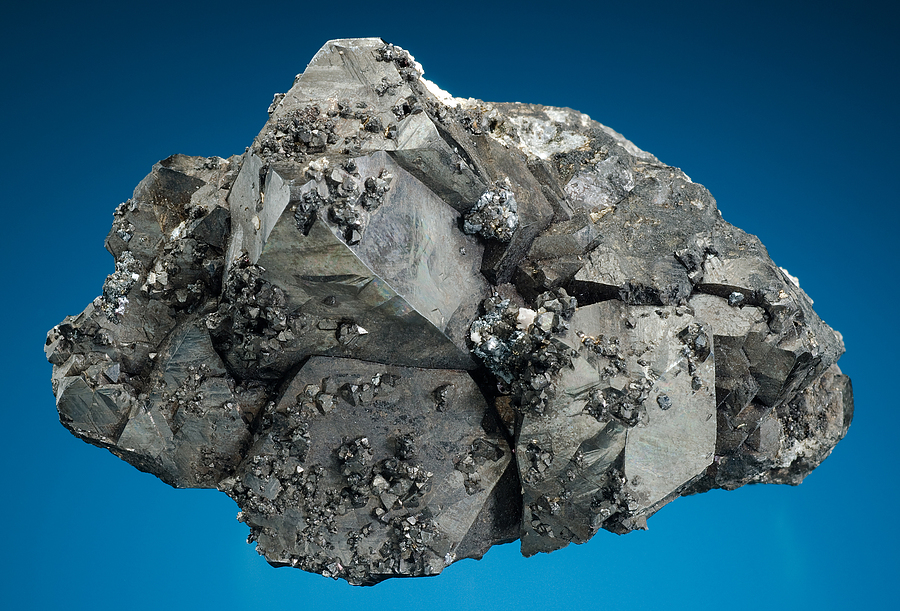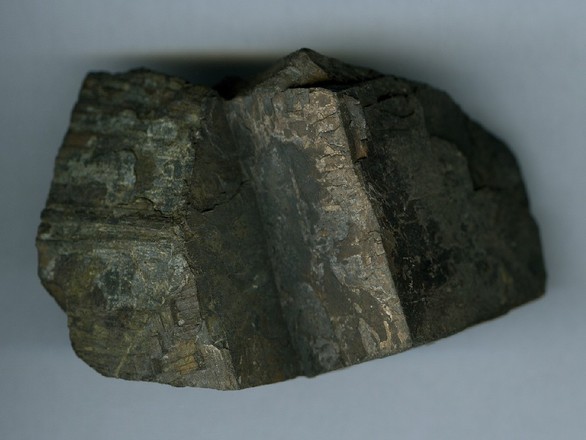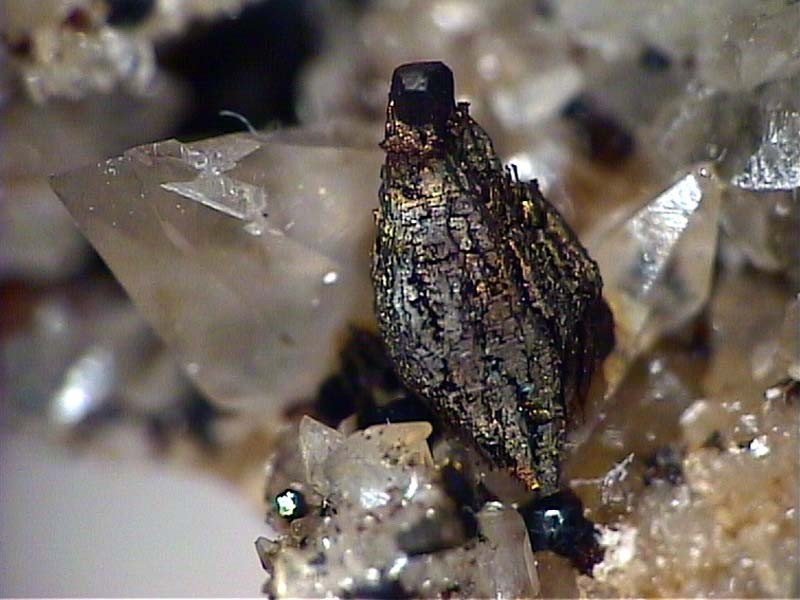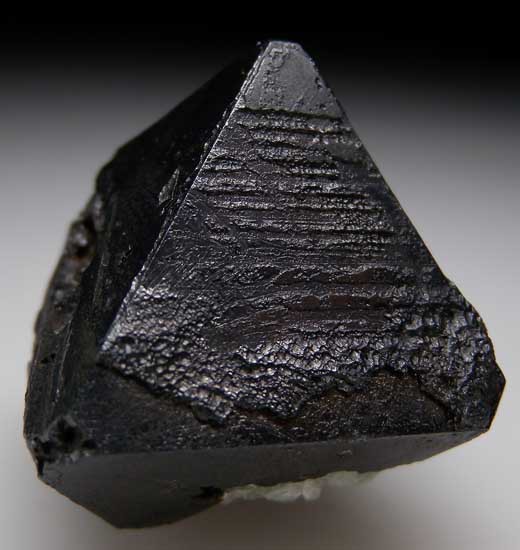Alabandite is a black manganese mineral and one that most collectors don't fight over let alone know much about. The Handbook of Mineralogy that usually lists the size of the largest crystals is silent on the subject so I will say that probably the largest crystals are about in inch in diameter and are those from the classical locality of Nagyág, Romania and the recent find (2008?) at Uchucchacua Mine, Peru. The specimens Nagyág do not appear to be free standing crystals like those from the newer Peruvian locality and the specimen pictured above may be the best specimen of alabandite from anywhere. Also very desirable are the somewhat divergent radial fans of crystals from the find at Broken Hill Australia which if my memory serves me are sometimes in "fans" up to about 15 cm. They may have grown a bit in my memory and if some kind Australian chap with a ruler can measure what the largest ones are, Ill be glad to make the necessary corrections here. The Australian specimens are not very well crystallized but represent freestanding material. Mindat currently lists a few more than 200 localities for the mineral. I have selected a few of them that I consider to be the "better" localities to be listed below with some description or a picture(s). If you think other localities should be listed here, respond with a thread entry of your own and make your case and provide a good picture and we will add it to the localities represented below.
Australia
Zinc Corporation Mine (ZC Mine), Southern operations mine (Pasminco mine; Perilya mine; Consolidated Zinc Mine; CRA mine; New Broken Hill Consolidated Mine; NBHC Mine), Broken Hill, Broken Hill district, Yancowinna Co., New South Wales, Australia
A remarkable find of matte black alabandite in arborescent forms was found in the 1960’s on the 18th level of this mine. There were probably several hundred specimens of this material found in pieces up to about a foot in diameter. The crystal shape on these specimens is poor but the arborescent formations that the crystals make are attractive. You may find a good one for sale, but the odds are against it. Some of the specimens show steep stacked hexagonal pyramids that make up the various "ribs" and it has been suggested that the "fans" of alabandite from this locality may be pseudomorphs. Ralph Bottrill says "The Broken Hill material is complex - it probably formed as sprays of acanthine crystals of the hexagonal, high temperature polymorph (rambergite), which inverted on cooling to a mixture or crystalline and earthy alabandite. It has also been partly altered to a thin coating of rhodochrosite and haussmanite."1. So these pseudomorphs at one time may have been the finest Rambergites ever known. Albert Chapman traded a beautiful one to the British Museum of Natural History for a wonderful bournonite from Herodsfoot, Liskeard, Cornwall. Today the bournonite would probably sell for more than $100,000. Well today Albert's Herodsfoot bournonite is in an Australian museum and not likely escape any time soon, and the British Museum has one of the best of these alabandite specimen in their display. In the overall scheme of things probably not a bad deal.
1. Personal communication Ralph Bottrill 2009.
Peru
Zinc Corporation Mine (ZC Mine), Southern operations mine (Pasminco mine; Perilya mine; Consolidated Zinc Mine; CRA mine; New Broken Hill Consolidated Mine; NBHC Mine), Broken Hill, Broken Hill district, Yancowinna Co., New South Wales, Australia
This silver mine is usually better known for its rhodochrosite specimens and various silver sulphide minerals. At Tucson 2009 Bill Pinch (Tucson, Arizona) found this wonderful alabandite specimen with Jaroslav Hyrsl who has for many years specialized in specimens from Peru. He found this specimen in a small collection of specimens from the mine and it may be the finest specimen of alabandite from anywhere. Since that time quite a few other specimens of fine alabandite crystals have been found at the mine and have appeared on the market. It is undoubtedly the best locality yet discovered for this species.
Romania
Săcărâmb, Certeju de Sus, Hunedoara County, Romania
This is the type locality for alabandite. Sometimes they produced large somewhat rough black isometric crystals (not free standing) up to almost 3 cm were found. If you like good crystal shape over pretty arborescent forms, you will want to try for one of these. I think a hen’s tooth or chicken lips would be easier to find.
Russia
Vysokogornoe Mn deposit, Kongor river, Suntar-Khayata Range, Oymyakonsky District, Sakha, Russia
The MinDat description of the locality says: ...veinlets of pure alabandine in granite host rock become pure rodochrosite ones in shist host rocks.
Sweden
Garpenberg Norra Mine, Garpenberg, Hedemora, Dalarna County, Sweden
The crystals from this locality are found up to about 5mm. They are found scattered on calcite crystals with pyrrhotite, rambergite and other sulfides. The locality is a skarn that is mined for base metals. The specimens were mostly found about 1995 to 2000. Some collectors had a good relationship with the mine management and the management put some of the material out on the dump for collectors to collect and it was from this dump material that most of the specimens were produced. Only a few hundred specimens were produced.
The associated minerals together with the alabandite crystals on calcite crystals are pyrrhotite, asphaltum, pyrite(?), and cubanite but NOT rambergite. As far as I know- most of this material came from deep levels~800 m (my own selfcollected are from 790).
Rambergite occurs in small cavities together with fluorite, apofyllite, calcite, barite, sphalerite, galena, samsonite, pyrargyrite, pyrrhotite and small amounts of freibergite. ( transl from summary descr: ). The 2 Rambergite crystals I have occur in a diopside-rhodo skarn.
The phrase "and the management put some of the material out on the dump for collectors to collect" is somewhat imprecise. The dumps was created as an intermediate storage for the mine, not intended for collectors but the management did allow collecting if one asked for permission.
Tanzania
Merelani Hills, Lelatema Mountains, Simanjiro District, Manyara Region, Tanzania
USA
Lucky Cuss Mine, Tombstone Mining District, Cochise County, Arizona, USA
In the American Museum of Natural History, probably part of the Bement collection are several specimens of alabandite that have pure cleavable masses of black alabandite up to a bit more than 2 inches across.1 It would be very nice to know more about the alabandites from this locality, like what mine they came from, their geological setting, the minerals they formed with, etc, but since the mines in that district have been closed for so long and the specimens are more than 100 years old it is more than likely that the person(s) who collected them and knew about them are long dead. There is a reference to Alabandite for the Lucky Cuss mine that dates back to 1892, so we have already lost whoever could tell us about those specimens.2
1. Demetrous Pohl, personal communication February 2009. 2. Mineralogy of Arizona, Anthony, Williams, Bideaux & Grant, 3rd edition p.104.
Sierra Grande Mine, Lake Valley Mining District, Sierra County, New Mexico, USA
We need someone to tell us about the Alabandite specimens from this locality.
RevisionHistory | |||||||||||||||||||||||||
|
Article has been viewed at least 20840 times.






















































